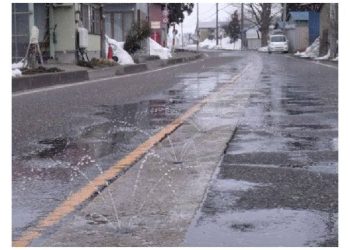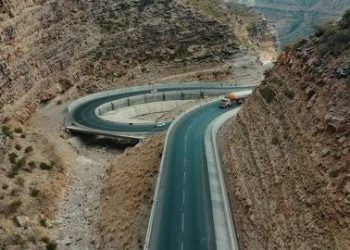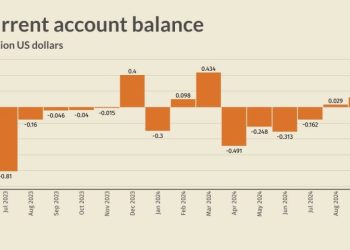Ukraine’s nuclear regulator Energoatom on Monday accused Russia of bombing power lines to sever the Zaporizhzhia plant from the Ukrainian electrical grid and goading Ukrainian forces positioned across the river into attacks. It said the plant’s staff were forced to close one of its six reactors over the weekend after an attack that severed a high-voltage power line, damaged three radiation monitors and shattered 800 square meters of window surfaces.
There has been no damage to the reactors and no radiological release, but Energoatom said a missile landed near a dry spent-fuel storage facility where 174 containers were being held in the open.
Kremlin spokesman Dmitry Peskov blamed Ukraine for shelling the plant and warned of “catastrophic consequences for a vast territory, including the territory of Europe.” U.N. Secretary-General
António Guterres
called for nuclear inspectors to be given access to the 5.7-gigawatt plant.
Plant staff and Ukrainian officials and diplomats following the case said Russia appears to be trying to steal the nuclear plant, Europe’s largest, by disconnecting it from the Ukrainian national electrical grid and eventually reconnecting it to Russia’s—and abducting and assaulting technicians who oppose that project.
The changeover would be costly, time-consuming and of limited benefit to Russia, which has already had a considerable supply of nuclear power. But it would be a potent and symbolic victory for President
Vladimir Putin
six months into his increasingly costly and grinding invasion of Ukraine.
Russia has controlled the Zaporizhzhia plant since early in the war—a Russian serviceman stood guard out front in May—but Ukrainian staff are still operating it.
Photo:
andrey borodulin/Agence France-Presse/Getty Images
No nuclear plant has ever been occupied, nor transferred from one country to another, in the history of warfare.
“This is playing with fire,” said Morgan D. Libby, a nuclear oversight officer at Excel Services Corporation, and veteran safety expert who spent years working in plants in the former Soviet Union, including Zaporizhzhia. “They’ve got a bunch of guys running around with guns in the air, everybody is all upset, people are working long hours, they’re scared. This is not the time for this.”
The Zaporizhzhia plant has been controlled by the Russians since the early days of the war, but Ukrainian staff are still operating it. Some 500 Russian troops are defending the complex, which they have turned into a military base overlooking an active front, intensifying a monthslong safety crisis for the vast facility and its thousands of staff.
The Russians have recently deployed heavy artillery batteries and laid anti-personnel mines along the shores of the reservoir from which water cools the plant’s six reactors, according to workers, residents, Ukrainian officials and diplomats. The Ukrainian army holds the towns dotted on the opposite shore, some 3 miles away, but sees no easy way to attack the plant, given the inherent danger of artillery battles around active nuclear reactors.
Ukrainian officials have been criticized by some nuclear experts for overly alarmist warnings over safety at both Zaporizhzhia and at Chernobyl, which was occupied by Russian forces before they relinquished that territory in March. The U.N.’s nuclear regulator, the International Atomic Energy Agency, however, has warned that nearly all of what it calls the seven pillars of nuclear safety have been compromised at Zaporizhzhia, including the physical integrity of the building, regular off-site monitoring of radiation, and the steady flow of spare parts, fuel and supplies. The agency has repeatedly lost data feeds relaying safety data and security footage from the plant to its Vienna headquarters, as Russia disconnects Ukrainian telecom providers and attempts to roll out Russian cell service.
Artists painted on automobiles destroyed by Russian forces. The vehicles were once owned by Ukrainian civilians and are now stored at car cemetery in Irpin.
Photo:
Serhii Korovayny for The Wall Street Journal
A crater inside a wheat grain storage was left by a Russian missile strike in the Zaporizhzhia region last week.
Photo:
STRINGER/REUTERS
Although the missile strikes on the plant are dominating international headlines, the key risk may be the degradation of safety protocols and exhaustion of a skeleton staff working under occupation, nuclear experts and plant workers say.
Ukrainian nuclear safety protocols use a vast number of staff to watch over systems that in a Western plant would be more computerized and automated. “When you have an accident you want people to be rested, prepared and ready to go. Nobody is rested, prepared and ready to go,” Mr. Libby said.
The U.N. regulator has lobbied for months to negotiate safe passage to inspect the plant. Ukrainian diplomats on Monday renewed calls for an urgent international mission.
The Russian delegation to the IAEA also called for an inspection on Monday, according to a note circulated among diplomats in Vienna.
But neither side has been able to agree on the parameters for a visit. Russia has insisted inspectors pass through the occupied peninsula of Crimea to reach the plant, citing safety concerns. Ukraine worries that such a route would validate Russia’s territorial conquests, and turn a nuclear inspection into a propaganda display of no real safety benefit. Ukraine has asked that any mission should embark from Kyiv.
“Russia doesn’t need international experts to fix or see what they’ve done,” said a Ukrainian diplomat closely involved with the country’s discussions with the IAEA. “This is the first time in war that someone is stealing a nuclear power plant.”
A man tries on a camouflage costume made by volunteers in Kyiv.
Photo:
Serhii Korovayny for The Wall Street Journal
The U.S. says Russia is using the Zaporizhzhia plant as a shield for its forces to target nearby areas such as Nikopol city, where a house was recently damaged by a Russian strike.
Photo:
STRINGER/REUTERS
The Ukrainian mayor of the nearby city of Enerhodar, Dmitry Orlov, who fled after the occupation, said the most recent Russian shelling hit the plant on Sunday at around 3:30 p.m. local time, wounding a worker named Yulia Yanzhula. Ms. Yanzhula was in intensive care with shrapnel lodged in her chest, he said.
Last week, U.S. Secretary of State
Antony Blinken
accused Russia of using the plant as a shield for its forces to target areas across the river like the city of Nikopol, which has come under heavy shelling in recent weeks.
On Monday, the Moscow-installed head of the Zaporizhzhia region signed a decree to hold a referendum on joining Russia, according to Russian state newswires, the latest in a series of votes organized by Moscow to entrench its rule in occupied territories. Mr. Peskov said it was inhabitants of Russian-controlled areas that were planning referendums to join Russia, not Moscow.
Ukrainian officials say those plans by Russia have resumed after a pause following Ukrainian strikes on infrastructure, but that Moscow is now expediting preparations for the referendums and moving away from the idea of a single day of voting on Sept. 11 toward a week of casting ballots instead.
In a video address late on Sunday, Ukrainian President
Volodymyr Zelensky
warned people not to collaborate with separatists and warned that the Russian shelling of Zaporizhzhia poses a huge risk to all of Europe.
“God forbid something irreversible happens. No one will stop the wind that will spread radioactive pollution,” he said.
Russia has suffered high casualty rates for some of its battlefield gains, the Pentagon said Monday, as the U.S. extended to Ukraine another $1 billion in military aid.
Buildings in Horenka, Ukraine, destroyed by Russian artillery during the battle for Kyiv earlier this year.
Photo:
Serhii Korovayny for The Wall Street Journal
The Pentagon said that as many as 80,000 Russian troops have been wounded or killed in less than six months of fighting in Ukraine, the first time the U.S. military announced its estimates of the toll of the invasion on Russia. The Pentagon didn’t provide casualty estimates for Ukrainian forces.
The Biden administration said the new $1 billion aid package would include thousands of rounds of ammunition and medical vehicles to treat soldiers on the front lines. In all, the U.S. has provided Ukraine $9.8 billion in military aid under the Biden administration.
—Georgi Kantchev and Nancy A. Youssef contributed to this article.
Write to Matthew Luxmoore at Matthew.Luxmoore@wsj.com, Drew Hinshaw at drew.hinshaw@wsj.com and Joe Parkinson at joe.parkinson@wsj.com
Copyright ©2022 Dow Jones & Company, Inc. All Rights Reserved. 87990cbe856818d5eddac44c7b1cdeb8








